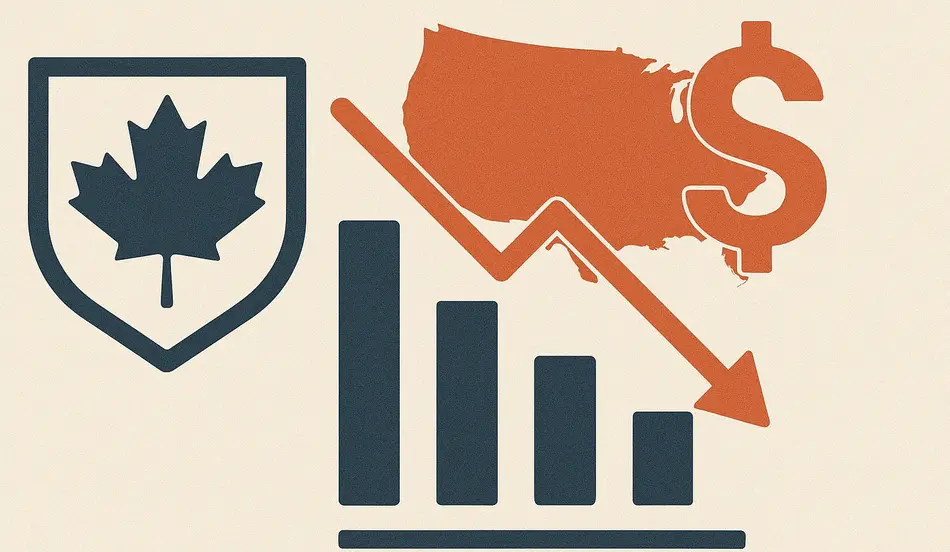In today’s volatile global trade environment, Canadian tariff impact analysis has become essential for understanding the economic challenges facing our northern neighbor. Recent reports from Deloitte Canada highlight how American duties are poised to become the most significant threat to Canadian economic growth in the second half of 2024. This in-depth Canadian tariff impact analysis examines the far-reaching consequences of these trade tensions, their regional impacts, and potential policy responses to mitigate economic damage.
The Severity of US Tariff Threats to Canadian Growth
The latest economic data paints a concerning picture for Canada’s economic outlook. This Canadian tariff impact analysis reveals how trade tensions with the United States have created significant uncertainty for businesses and consumers alike.
Market Recovery and Ongoing Concerns
While markets have partially recovered from the initial tariff disruption shock, Deloitte’s comprehensive report identifies US duties as the most damaging factor for Canadian growth moving forward. According to Dawn Desjardins, Chief Economist for Deloitte Canada, “We do have steel and aluminum, of course, lumber, finished autos that are still facing some very high tariffs. And that is definitely impacting those industries.”
Business Confidence Crisis
The lack of clarity regarding the US-Canada trade relationship has severely undermined business confidence. As Desjardins explains in her Canadian tariff impact analysis, “What we’re thinking is we need to have something just a little clearer for businesses to be able to be confident and put some money to work in the economy.” This uncertainty has created a wait-and-see approach among Canadian businesses, delaying critical investments and hiring decisions.
Employment Stagnation
One of the most troubling indicators identified in this Canadian tariff impact analysis is the stagnation in job creation. “We are seeing labor data unemployment rate has risen. We really haven’t created any jobs since January of this year,” notes Desjardins. This employment freeze has further dampened consumer confidence, creating a negative feedback loop that threatens to depress economic activity further.
Regional Disparities in Tariff Impact
The effects of US tariffs are not being felt equally across Canada’s diverse economy. This section of our Canadian tariff impact analysis examines how different regions are experiencing varying degrees of economic pressure.
Manufacturing Heartland Under Pressure
Ontario and Quebec, Canada’s manufacturing powerhouses, are experiencing the most severe economic slowdown. According to Deloitte’s research highlighted by The Conference Board of Canada, “We have Ontario and Quebec barely growing, and this reflects a few things. One, of course, is that they do have manufacturing moved, and so they are definitely where they’re in the eye of the storm in terms of the tariffs.”
Population Growth Challenges
Beyond direct tariff impacts, this Canadian tariff impact analysis identifies concerning demographic trends that compound economic challenges. “Additionally, we’re seeing fewer people come to Canada. That’s across the country, obviously, but it will have a significant impact on Ontario in particular,” explains Desjardins. This slowing population growth translates directly to reduced labor force expansion and weakened consumer spending.
Uneven Recovery Prospects
Regional recovery from tariff impacts will likely be uneven, according to experts at Export Development Canada. Areas heavily dependent on steel, aluminum, and automotive manufacturing face steeper challenges than regions with more diversified economic bases. This Canadian tariff impact analysis suggests that targeted regional support may be necessary to address these disparities effectively.
Labor Market Outlook Amid Trade Tensions
The Canadian labor market has shown concerning signs of weakness in response to trade uncertainties. This Canadian tariff impact analysis examines the employment outlook and potential paths to recovery.
Unemployment Projections
With unemployment already at 7%, Desjardins projects a modest further increase: “We think probably to top out at about 7.2%. It’s not a lot higher. And that’s simply to say that we don’t have massive job losses associated with this forecast.” This relatively contained unemployment increase suggests businesses are primarily freezing hiring rather than implementing large-scale layoffs.
Sector-Specific Vulnerabilities
This Canadian tariff impact analysis identifies particular vulnerability in sectors directly impacted by tariffs. “Some will have to [cut jobs] simply because, as the steel aluminum industry, you know, just not seeing the demand,” explains Desjardins. These targeted job losses in trade-exposed sectors could create concentrated pockets of economic hardship even if the broader unemployment picture remains relatively stable.
Recovery Timeline Uncertainty
The path back to job growth remains uncertain and contingent on policy responses. According to labor market analysts at Statistics Canada, significant job creation is unlikely to resume until trade certainty improves and businesses regain confidence in the economic outlook. This Canadian tariff impact analysis suggests that employment recovery will lag behind other economic indicators.
Policy Responses to Mitigate Tariff Damage
Canadian policymakers face difficult choices in responding to US tariff pressures. This section of our Canadian tariff impact analysis examines potential policy interventions and their likely effectiveness.
Infrastructure Investment Potential
Bill C-5, the government’s infrastructure initiative, represents a potential counterweight to tariff-related economic drag. Desjardins notes that significant infrastructure spending could signal “that Canada has to up its game, that we have to be able to attract capital because global capital is very fluid and will only go where they anticipate getting the best and the quickest returns.”
Regulatory Reform Opportunities
Beyond direct spending, this Canadian tariff impact analysis identifies regulatory streamlining as a critical area for improvement. “Changing the way we apply for permits and how long those permits take” could significantly improve Canada’s investment attractiveness, according to Desjardins. These reforms would signal to businesses “that they can put money to work in Canada, get a return on investment in a reasonable timeframe.”
Inter-Provincial Trade Barrier Reduction
Internal trade barriers between Canadian provinces represent another area where policy reform could offset tariff damage. According to research from the C.D. Howe Institute, reducing these barriers could add billions to Canada’s GDP. This Canadian tariff impact analysis suggests that domestic market integration could partially compensate for restricted US market access.
Timing Challenges for Economic Intervention
The effectiveness of policy responses depends critically on timing. This Canadian tariff impact analysis examines the temporal dimensions of Canada’s economic challenges.
Parliamentary Calendar Constraints
With Parliament not sitting until September, there’s a significant lag between policy development and implementation. This timing gap creates challenges for rapid economic intervention, particularly as tariff impacts continue to accumulate through the summer months.
The Signaling Effect
Despite implementation delays, Desjardins emphasizes the importance of clear policy signals: “I think the signaling to like when we think about it, if the government is committed to putting X billion into the economy to create a pipeline, a rail line, whatever it is, it’s the signaling for businesses.” This Canadian tariff impact analysis suggests that credible policy announcements could boost confidence even before actual spending occurs.
The Urgency of Trade Relationship Clarity
Perhaps most critically, businesses need clarity regarding the US-Canada trade relationship. “If I put that together with a sense that maybe we don’t have any big risks of more tariffs coming and perhaps this relationship we have with the US right now with our car bouts and the ability of our goods to travel to the US basically tariff-free at this point… if that persists and we get some further assurance on that, that we, they will comply with our agreement, I think those two factors together should be sufficient to lift business investment,” explains Desjardins.
Global Context of Trade Tensions
Canada’s tariff challenges exist within a broader global trade environment. This Canadian tariff impact analysis examines how international factors influence Canada’s economic outlook.
Shifting Global Supply Chains
The US-Canada trade tensions are occurring against a backdrop of global supply chain realignment. According to international trade experts at McKinsey & Company, companies worldwide are reevaluating their supply chain strategies to prioritize resilience over pure efficiency. This creates both challenges and opportunities for Canadian businesses seeking to diversify their market exposure.
Comparative Trade Policy Approaches
This Canadian tariff impact analysis notes that Canada’s situation is not unique. Countries worldwide are navigating increasingly protectionist trade environments. The European Union, for instance, has implemented its Carbon Border Adjustment Mechanism, while Japan and South Korea have strengthened their economic security frameworks. These parallel developments suggest potential for international coordination on trade policy responses.
Economic Diplomacy Opportunities
Beyond direct policy interventions, Canada has opportunities to pursue economic diplomacy to mitigate tariff impacts. According to foreign policy analysts at the Canadian Global Affairs Institute, strengthening trade relationships with partners like the European Union, United Kingdom, and Indo-Pacific nations could partially offset US market access challenges. This Canadian tariff impact analysis suggests that trade diversification should be a strategic priority.
📘 Need Career Advice?
Are you interested in economics, international trade, or policy analysis? Your interests could translate into a rewarding career in economic research, trade policy, or business strategy.
Developing expertise in areas like Canadian tariff impact analysis and global trade dynamics can lead to exciting opportunities with governments, consulting firms, and multinational organizations.
Explore career paths in economics and trade policy on WhatJobs and discover roles that align with your passion for global commerce and strategic thinking.
👉 Browse Economics & Trade Policy JobsConsider exploring these related career paths:
- Economic analyst
- Trade policy advisor
- Supply chain consultant
- Business strategy specialist
- Government relations professional
- International business development manager
Navigating Forward Through Uncertainty
While current economic indicators present challenges, this Canadian tariff impact analysis suggests that Canada has pathways to resilience. The combination of strategic infrastructure investment, regulatory reform, and trade relationship clarity could create conditions for renewed business confidence and economic growth.
As Desjardins notes, the current situation reflects “almost a against not expanding for businesses. They’re not looking to cut their labor force significantly.” This suggests that with appropriate policy interventions and improved trade certainty, Canada could relatively quickly return to a growth trajectory. The key will be creating sufficient clarity for businesses to move beyond their current wait-and-see approach to investment and hiring.
FAQ About Canadian Tariff Impact Analysis
What does recent Canadian tariff impact analysis reveal about the most affected industries?
Recent Canadian tariff impact analysis shows that steel, aluminum, lumber, and finished automotive products are facing the highest tariffs and experiencing the most significant disruptions. These industries are concentrated in Ontario and Quebec, explaining why these provinces are experiencing the slowest growth. According to Deloitte’s research, these sectors are seeing reduced demand, production constraints, and in some cases, job losses as companies adjust to the new trade reality.
How is business confidence affected according to Canadian tariff impact analysis?
According to current Canadian tariff impact analysis, business confidence has been severely undermined by trade uncertainty. Surveys indicate businesses believe it’s “probably not a good time to put money to work” and they’re hesitant to expand hiring. This lack of confidence is creating a self-reinforcing cycle of economic caution, with companies delaying investments until they have greater clarity about the US-Canada trade relationship and potential future tariffs.
What unemployment trends are emerging based on Canadian tariff impact analysis?
Canadian tariff impact analysis indicates that unemployment has risen to 7% and could peak at approximately 7.2%. The labor market has essentially stagnated since January 2024, with virtually no net job creation. Rather than massive layoffs, most businesses are implementing hiring freezes while they assess the economic outlook. However, certain sectors directly impacted by tariffs, particularly steel and aluminum, are experiencing more significant job losses due to reduced demand.
How might Bill C-5 impact the economy according to Canadian tariff impact analysis?
Canadian tariff impact analysis suggests that Bill C-5, the government’s infrastructure initiative, could provide a meaningful economic counterweight to tariff pressures if implemented effectively. The bill’s focus on streamlining approvals for major infrastructure projects could attract investment by signaling that Canada is serious about improving its business environment. However, the effectiveness depends on timely implementation and clear communication about the government’s commitment to putting “X billion into the economy” for specific projects.
What regional disparities exist in tariff impacts according to Canadian tariff impact analysis?
Current Canadian tariff impact analysis identifies significant regional disparities in how tariffs are affecting Canada’s economy. Ontario and Quebec are “barely growing” as they host most of the manufacturing sectors directly targeted by US tariffs. These provinces are also particularly affected by slowing population growth, which compounds economic challenges. Other regions with more diversified economies or less exposure to tariffed sectors are experiencing less severe impacts, though the national economic slowdown affects all areas to some degree.
What policy approaches could mitigate tariff damage based on Canadian tariff impact analysis?
Canadian tariff impact analysis identifies several promising policy approaches to offset tariff damage. These include strategic infrastructure investment, regulatory reforms to speed up permit approvals, reduction of inter-provincial trade barriers, and clear communication about the government’s economic strategy. Most critically, efforts to secure greater clarity and stability in the US-Canada trade relationship would restore business confidence. The analysis suggests that combining these approaches could create sufficient conditions for renewed business investment despite ongoing tariff challenges.




